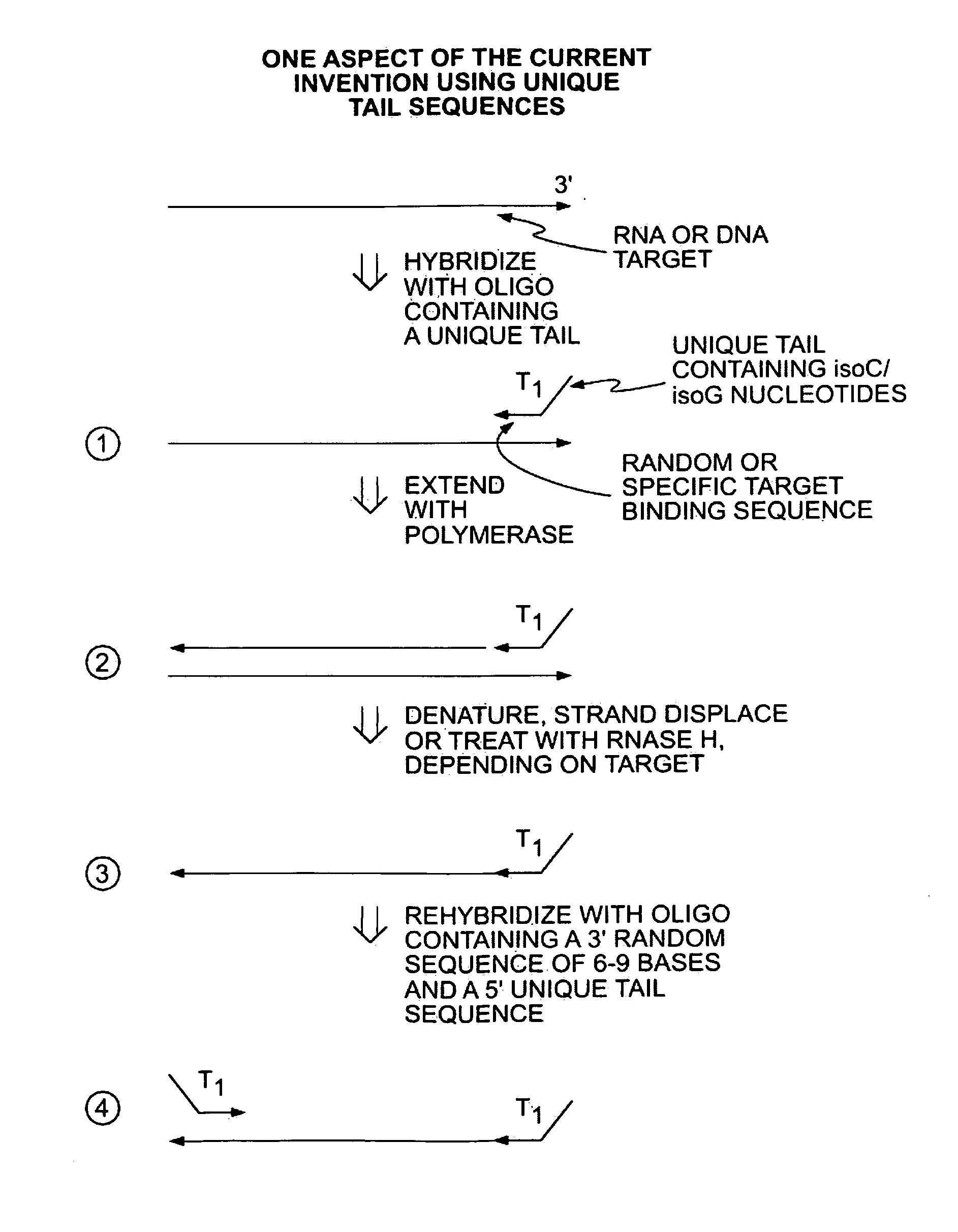Methods for Amplifying a Complete Genome or Transcriptome
a technology of complete genome and transcriptome, applied in combinational chemistry, dna preparation, library creation, etc., can solve the problem of not intentionally fragmenting, and achieve the effect of reducing or eliminating mispriming and reducing primer dimerization
- Summary
- Abstract
- Description
- Claims
- Application Information
AI Technical Summary
Benefits of technology
Problems solved by technology
Method used
Image
Examples
first embodiment
[0044]In a first embodiment, a single primer or set of primers may be used for binding the target nucleic acids. Each primer comprises a random target binding region, preferably about 6-9 nucleotides in length, and a tag sequence containing unique non-natural nucleotides, such as L-ribose or isoC and isoG. The non-natural nucleotides will bind to the complementary non-natural nucleotides but are not capable of binding natural nucleic acids (i.e., A, C, G, T and U). In a preferred embodiment, a single primer is used for binding the target nucleic acids.
[0045]In another embodiment, 2 or more primers may be used. In this case, the primers may all share the same target binding sequence (e.g., a random sequence 6 to 9 nucleotides in length) but have different tag regions to introduce distinct functionality on each side of the produced nucleic acid. For example, the produced nucleic acid may have distinct primer binding sites on the two termini and / or a barcode sequence on one terminus an...
second embodiment
[0048]In a second embodiment, mRNA is the desired target nucleic acid. In this method, the mRNA may be converted into a first cDNA strand by using a primer that targets the poly-A junction region or the poly-A tail. A generic primer containing a target binding region that comprises a short random nucleic acid sequence of 1 to about 3 base pairs in length, referred to as the wobble sequence, together with a poly-T region containing about 8 to about 15 nucleotides in length may be used to prime the junction region. A primer that comprises a poly-T region containing about 8 to about 18 nucleotides in length may also be used. The chosen primer is annealed to the target mRNAs and extended by polymerase. The mRNA strands are then removed (e.g. by RNaseH) and the cDNAs produced may then be amplified with the methods of the present invention.
[0049]Alternatively, the primers may further comprise a tag sequence such as the T1 tag shown in FIG. 1. After primer extension and removal of the RNA ...
third embodiment
[0051]In a third embodiment, applications of these methods may be utilized for further manipulation of the amplicons including for example detection and / or sequencing. More specifically, the unique engrafted tail sequences from the amplification method above may be used to simplify a broad range of subsequent manipulations. For example, the unique tail sequences may be utilized to capture and purify the amplicon products. Providing complementary sequences to the tail sequences on a solid support, such as a magnetic bead, amplicons may be captured and then purified from the reaction mixture by elution. In specific applications it may be beneficial to have a single amplicon bound to a solid support. This can be achieved when the number of magnetic beads, for example, exceeds the number of amplicons in the reaction mixture.
[0052]In a second application, the amplicon bound beads may be deposited into single pores or wells, amplified further if desired and sequenced.
[0053]In a third appl...
PUM
| Property | Measurement | Unit |
|---|---|---|
| sizes | aaaaa | aaaaa |
| nucleic acid | aaaaa | aaaaa |
| length | aaaaa | aaaaa |
Abstract
Description
Claims
Application Information
 Login to View More
Login to View More - R&D
- Intellectual Property
- Life Sciences
- Materials
- Tech Scout
- Unparalleled Data Quality
- Higher Quality Content
- 60% Fewer Hallucinations
Browse by: Latest US Patents, China's latest patents, Technical Efficacy Thesaurus, Application Domain, Technology Topic, Popular Technical Reports.
© 2025 PatSnap. All rights reserved.Legal|Privacy policy|Modern Slavery Act Transparency Statement|Sitemap|About US| Contact US: help@patsnap.com



